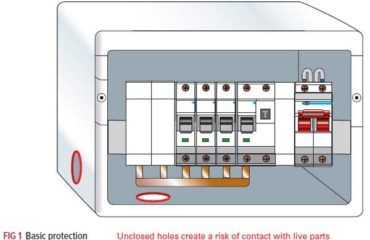Consumer units (CU) are replaced for various reasons. This includes replacement where the existing unit does not meet the requirements of BS 7671, for example, where there is no RCD protection. Or there may be no spare capacity in the existing consumer unit to connect additional circuits. Or, it may be that replacing the unit has been a recommendation following a periodic inspection or it could be that the existing consumer unit is in a poor condition.

This article will discuss some basic considerations when replacing a domestic consumer unit.
Considerations and potential pitfalls
From the outset, discussions with the client are needed to ensure that they are fully aware of what’s involved. Replacing a consumer unit can be a big job and if it is not planned competently it can leave the contractor with numerous problems.
Accurate information and checks at an early stage can prevent many problems from arising and they will also help with the design and installation of the new unit. As a minimum, the following should be considered:
- Isolation of supply – is there a switch disconnector on the supply side of the CU? If not, have arrangements been made with the Distribution Network Operator (DNO)?
- Have the different types of CU configuration been discussed with the client? They could be dual RCD, high integrity or RCBO set-up.
- Has discrimination between any sub-mains been considered?
- Has the existing installation been assessed to ensure the CU replacement can be carried out?
The regulations
Many installers don’t fully appreciate how many regulations are associated with replacing a consumer unit. A common mistake is to carry out the work and believe that it is acceptable to note the existing defects on the Electrical Installation Certificate (EIC). Remember defects can only be recorded in the Comments on existing installation section if they do not result in a C1, C2 or FI classification code.
As well as complying with BS 7671, installers are reminded of the need to comply with the Electricity at Work Regulations 1989. This includes:
- Regulation 12 Means for cutting off the supply and for isolation
- Regulation 13 Precautions for work on equipment made dead
- Regulation 14 Work on or near live conductors.
Requirements of BS 7671
Replacing a consumer unit is classed as making an alteration and falls into the category of new work. This must be designed, erected and verified in accordance with BS 7671 as required by Regulation 110.1.2 (vi) and the safety of the existing installation must not be impaired as stated in Regulation 610.4.
Regulation 132.16 states the requirements of additions and alterations –this means existing equipment, including the distributor’s equipment – must be adequate for the alteration. The earthing and bonding must also be adequate for the installation.
The design will also need to consider Regulation 415.1 for additional protection by 30mA RCD and consideration of how to protect against unwanted tripping of the RCD(s) will be needed to comply with the requirements of Section 314, Division of Installation.
Account must also be taken of the manufacturer’s instructions as required by Regulations 134.1.1 and 510.3.
On completion, identification notices in accordance with Section 514 will need to be fitted and an EIC must be issued in accordance with the requirements of Sections 631 and 632, as stated in Regulation 631.1. Finally, the work must be notified (for England and Wales).
Industry best practice
After looking at all the requirements I’ve referred to, it shows just how easy it is to get something wrong. I will now set out what is considered to be industry best practice.
The customer should be encouraged to have an Electrical Installation Condition Report (EICR) carried out before replacing the consumer unit. This will help the contractor to establish that the requirements of Regulation 132.16 have been met to allow the new consumer unit installation to take place. Suitability of the existing earthing and bonding arrangements will be confirmed, as well as the suitability of the DNO’s equipment and meter tails, including polarity of the incoming supply.
Any faults or defects will be highlighted at this stage – allowing for remedial work to be planned and carried out as part of the consumer unit replacement or prior to its replacement. More importantly, the contractor will not be stuck at the end of the day with faults to clear that were not built into the original contract.
The EICR test results will also be available to help with the design and selection of protective devices for the new consumer unit. Remember, care is needed with the selection of protective devices to ensure that maximum disconnection times are met and that the maximum fault current breaking capacity of the device is not exceeded. It’s too late if you install the devices without prior testing and then find out that they are not adequately rated.
For single-phase supplies up to 100A, a prospective fault current value of 16kA is often quoted by DNOs. This is the value at the point where the service cable is joined to the DNO network. Unless the installation is close to the distribution transformer, this value is likely to be significantly less than 16kA due to the length of the service cable.
Domestic consumer units are typically supplied with Type B circuit- breakers to BS EN 60898 and RCBOs to BS EN 61009 standards – usually with a 6kA rating.
Regulation 434.1 requires that the prospective fault current must be determined at every relevant point of the installation. You should be aware that a relevant point is every point in the installation where switchgear is installed.
Source: https://www.voltimum.co.uk/articles/replacing-consumer-unit




